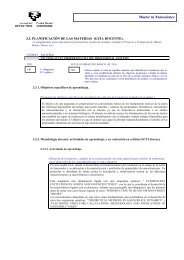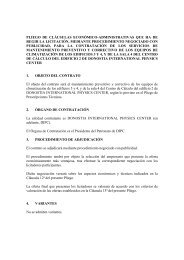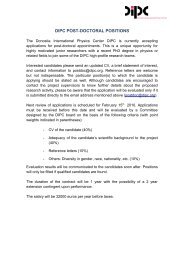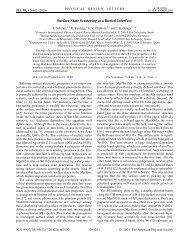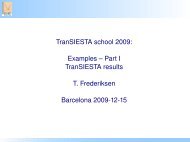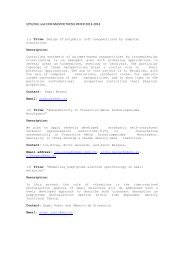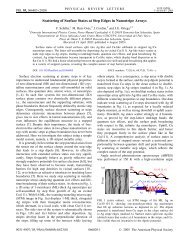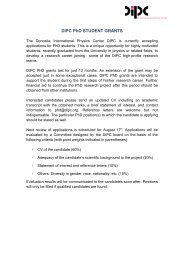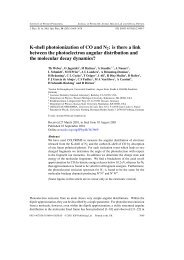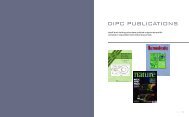SYMPOSIUM ON SURFACE SCIENCE 2011 Baqueira Beret, Lleida ...
SYMPOSIUM ON SURFACE SCIENCE 2011 Baqueira Beret, Lleida ...
SYMPOSIUM ON SURFACE SCIENCE 2011 Baqueira Beret, Lleida ...
You also want an ePaper? Increase the reach of your titles
YUMPU automatically turns print PDFs into web optimized ePapers that Google loves.
Interplay between Electronic correlations and Coherent<br />
Structural Dynamics during the Monoclinic<br />
Insulator-to-Rutile Metal Phase Transition in VO2<br />
H. Dachraoui, N. Müller, G. Obermeier 1 , C. Oberer, S. Horn 1 ,<br />
V. Eyert 2 , and U. Heinzmann<br />
Molecular and Surface Physics, Faculty of Physics, Bielefeld University, D-33615 Bielefeld,Germany<br />
(cooresponding author:N. Müller, e-mail: nmueller@physik.uni-bielefeld.de<br />
1 Experimental Physics II, Institute of Physics, University of Augsburg, Germany<br />
2 Center for Electronic Correlations and Magnetism,<br />
Institute of Physics, University of Augsburg, D- 86135 Augsburg, Germany<br />
Materials exhibiting photoinduced transitions from an insulating to a metallic phase are<br />
attractive candidates for ultrafast electrooptic applications because of the significant changes<br />
in the resistivity and extremely fast optical switching upon the transition[1]. Vanadium<br />
dioxide (VO2) is one example of these solids with strongly correlated electron systems: It<br />
undergoes a first-order transition from a high-temperature metallic to a low-temperature<br />
insulating phase at almost room temperature Tc = 340 K [2]. The IMT is accompanied by a<br />
structural phase transition from a monoclinic (M1) unit cell in the insulating phase to<br />
tetragonal (rutile) symmetry in the metallic phase. Two major mechanisms have been<br />
proposed to describe the isolator metal transition in VO2: the strong dimerization of V-V<br />
atoms in the low temperature phase, as well as the fact that this phase is nonmagnetic, have<br />
lead to the proposition that this transition is connected to a Peierls-like transition [3].<br />
However, the discovery of a second insulating phase (M2), in which only half of the V atoms<br />
form pairs while the other half form zig-zag chains that behave as magnetic insulators [4],<br />
suggested that the isolator metal transition should rather be regarded as a Mott transition<br />
[5, 6]. Recent theoretical and experimental work has shown that the VO2 phase transition<br />
results from the interplay of electronic correlations and structural distortions and can thus be<br />
regarded as a correlation-assisted Peierls transition [7, 8].<br />
We have directly probed the time evolution of electronic states in VO2 across the insulatormetal<br />
transition in VO2 by using near-infrared / EUV pump probe technique [9]. The<br />
femtosecond EUV pulses with photon energy of about 95 eV have been generated by means<br />
of High Harmonic Generation (HHG) and the phase transition has been initiated by the 50 fs<br />
fundamental near-infrared pump pulses. Due to direct EUV photoemission the V3p core<br />
levels and the hybridized V3d O2p valence band states are accessible. While the valence band<br />
states directly reflect their excitation by the near infrared pulses, the core level states reflect<br />
local changes of the valence band states resulting from the primary near infrared excitation as<br />
well as from structural changes.<br />
27



